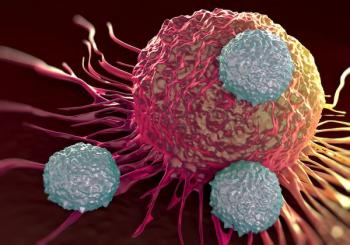
Oncology NEWS International
- Oncology NEWS International Vol 11 No 10
- Volume 11
- Issue 10
‘ATAQ’ Gets Antibiotics to Neutropenic Patients Sooner
WASHINGTON-Although leukemia patients with neutropenia need antibiotics promptly when fever strikes, hospital procedures can delay administration for many hours, according to Cathy Mazzone, RN, MS, OCN, patient care manager, National Institute on Aging, Bethesda, Maryland. A thorough analysis of the approach to neutropenia fever management by a busy leukemia unit cut the wait to just over an hour, she said at the 27th Annual Congress of the Oncology Nursing Society (abstract 22).
WASHINGTONAlthough leukemia patients with neutropenia need antibiotics promptly when fever strikes, hospital procedures can delay administration for many hours, according to Cathy Mazzone, RN, MS, OCN, patient care manager, National Institute on Aging, Bethesda, Maryland. A thorough analysis of the approach to neutropenia fever management by a busy leukemia unit cut the wait to just over an hour, she said at the 27th Annual Congress of the Oncology Nursing Society (abstract 22).
Implementing the philosophy that "Appropriate Treatment Assures Quality" (ATAQ) and working in concert with medical staff, an interdisciplinary team identified the sources of delay.
The team then developed strategies and materials to help the affected departments make it a priority to start neutropenic patients on antibiotics within an hour of either the discovery of the fever or their arrival at the emergency department. Oncologic, hematologic, and infectious disease experts validated the 1-hour goal, Ms. Mazzone said.
A 5- to 7-Hour Wait
Baseline studies showed that, on average, inpatients waited for antibiotics for more than 5 hours, and patients admitted through the emergency department waited 7 hours.
Barriers to prompt administration included lack of education among nurses and lack of recognition among staff in various departments, including pharmacists and emergency department physicians, that getting antibiotics to neutropenia patients is a high priority.
Education is key to changing this situation, the team decided. Mandatory in-service training for nurses and ancillary staff on the leukemia unit featured short lectures; discussion of case studies, including some from the unit’s own experience; practice calculating absolute neutrophil counts (ANCs); and Q&A handouts using nontechnical language appropriate for ward clerks. Amgen’s "Neutropenia A-Z" program is "excellent" for this purpose, Ms. Mazzone said.
Ancillary staff must be included because they are essential to information management and "things fall apart" without their cooperation, she added.
In the emergency department, neither clerks, residents, nor pharmacists were aware of the 1-hour deadline for starting antibiotics. Delays occurred because newly arriving patients were not in the computers, clerks waited for the default time to order prescriptions, and night pharmacists were often unfamiliar with oncology, she said.
An educational program, again including "Neutropenia A-Z," drew emergency department staff’s attention to the issue. An order set was developed to help residents, some of whom have established a standing order for neutropenic patients arriving with fever. Nurses are "really important in making sure this happens," Ms. Mazzone said.
In addition, the team advocated for a Neutropenia Alert card for outpatients to give the triage nurse when they come in for fever emergencies. Emergency staffs "need to know the 1-hour standard," Ms. Mazzone said, adding that they welcomed this innovation. Alert cards are especially useful for patients who do not speak English, she added.
Two years into the project, the most recent audit shows that neutropenic patients, both inpatients and outpatients admitted through the emergency room, are now receiving antibiotics within 1 hour and 20 minutes, on average, after staff become aware of their fever. In addition to education, audits, performed every 3 months, have been crucial to this effort, Ms. Mazzone noted. "What gets measured gets done," she concluded.
Articles in this issue
about 23 years ago
FDG-PET Predicts Prognosis in Primary Osteosarcomaabout 23 years ago
Vaccine Turns Immune System Against Cancer Cellsabout 23 years ago
Three Themes to Guide von Eschenbach at NCIabout 23 years ago
Arimidex Approved for Early-Stage Breast Cancer in Postmenopausal Ptsabout 23 years ago
Long-Term Exposure to Diesel Exhaust Poses Lung Cancer Riskabout 23 years ago
Most Americans Unaware of Excessive Weight as a Risk for Some Cancersabout 23 years ago
Three Themes to Guide von Eschenbach as NCI Directorabout 23 years ago
Gleevec Gets FDA Priority Review for First-Line Use in Early CMLabout 23 years ago
New Anti-HIV Agent Prevents Virus From Entering Cellabout 23 years ago
Docetaxel/Gemcitabine Effective in Advanced NSCLCNewsletter
Stay up to date on recent advances in the multidisciplinary approach to cancer.



















































































